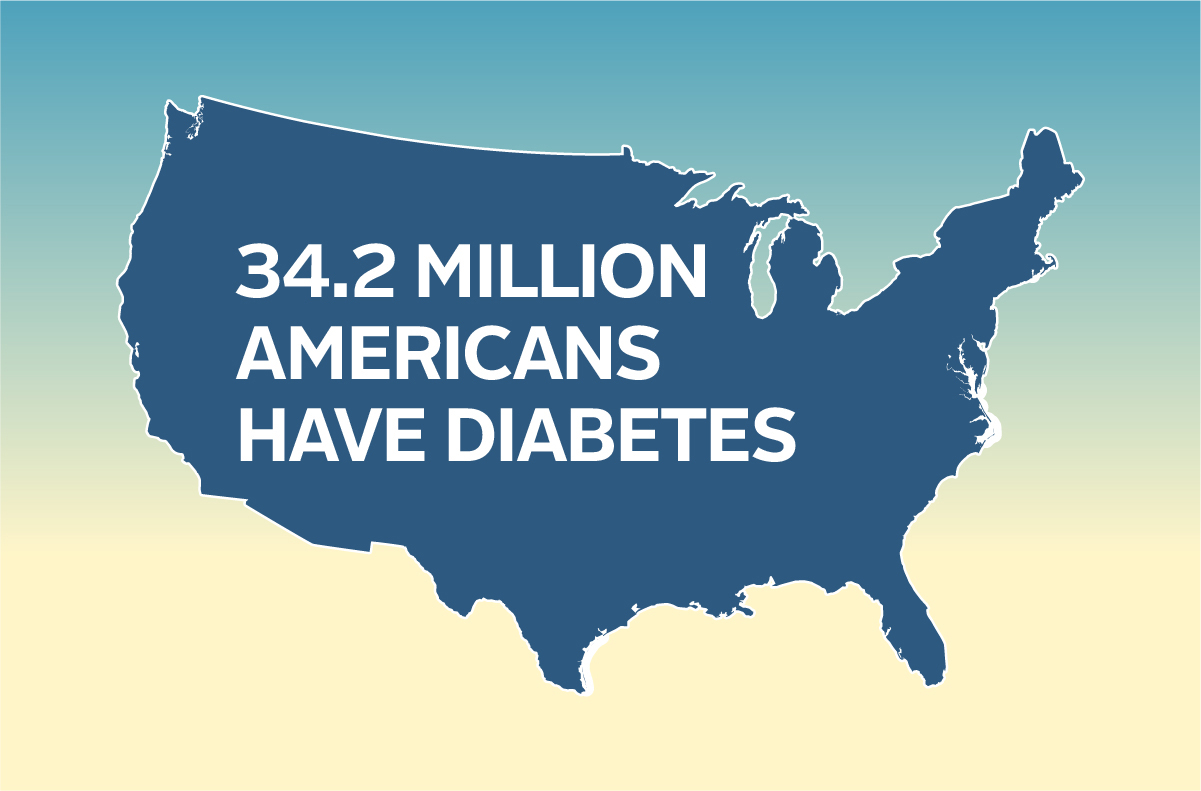Every November, people across the country come together to raise awareness about diabetes — a disease that affects more than 34 million Americans. Diabetes is the seventh leading cause of death in the U.S., and a major cause of nerve damage, kidney failure, blindness, heart attacks, stroke, and disabilities. But it’s not all doom and gloom. Diabetes is highly manageable, and with some moderate lifestyle changes, many of these complications can be prevented.
The Difference Between Type 1 and Type 2 Diabetes
There are two main types of diabetes: type 1 and type 2. Both versions are chronic, meaning they are ongoing and must be managed regularly with help from health care professionals. There is currently no cure for either form of diabetes.
Type 1 diabetes: With type 1 diabetes, the body doesn’t produce insulin. Insulin is important because it breaks down food and helps glucose (sugar) get to your cells so your body can use it for energy. Without insulin, glucose builds up in the blood. People with type 1 diabetes must take insulin daily. Although type 1 diabetes is typically diagnosed in children or adolescents, it can also occur in adulthood. About 10 percent of people with diabetes have type 1.
Type 2 diabetes: With type 2 diabetes, the body either doesn’t make enough insulin, or can’t process insulin correctly. Type 2 diabetes is the most common form of diabetes. It can either be managed through a healthy diet and exercise or through medication or insulin injections.
Other Forms of Diabetes
Prediabetes: Prediabetes is a condition where blood sugar levels are higher than normal. Although levels aren’t high enough to qualify as type 2 diabetes, without lifestyle changes, those with prediabetes are likely to develop type 2 diabetes.
More than 88 million American adults have prediabetes, but more than 84 percent don’t know they have it. This is because prediabetes does not have any symptoms. But there are plenty of risks. Prediabetes increases your risk of developing type 2 diabetes, heart disease, and stroke. The good news is that many people with prediabetes respond well to early treatment and lifestyle changes, and with some moderate tweaks, their blood sugar levels can return to normal.
Gestational diabetes: Gestational diabetes is a temporary version of diabetes that appears during pregnancy in people who did not previously have diabetes. With gestational diabetes, the body can’t make enough insulin. People with gestational diabetes are at a higher risk of complications both during their pregnancy and while giving birth. Those with gestational diabetes have an increased risk of developing type 2 diabetes in the future.
Know the Symptoms
Symptoms of diabetes are different for everyone, and may develop so slowly they go unnoticed. Many people do not have any signs or symptoms at all. Symptoms of diabetes may include:
- Increased thirst and hunger
- Frequent urination
- Cuts, bruises, or sores that do not heal
- Fatigue
- Blurry vision
- Tingling or numbness in the feet or hands
- Unexplained weight loss
Living Well with Diabetes
If you are living with diabetes, or have been recently diagnosed, it’s important to know that it is possible to manage your diabetes well, and not let it control your life. Yes, it’s a serious illness that can cause health complications if left unchecked, but it’s also very manageable.
Preventive care practices
According to the Centers for Disease Control and Prevention (CDC), people with diabetes who follow a few preventive care practices are better able to manage their diabetes. These practices include:
- Getting regular A1C tests
- Getting annual foot and eye exams
- Attending diabetes self-management classes
- Monitoring blood sugar levels every day
Lifestyle changes
There are steps you can take to reduce your risks for developing type 2 diabetes or to better manage this condition if you have it.
- Be physically active for at least 30 minutes every day.
- Choose healthier foods as often as possible. Pick foods that are high in fiber and low in saturated fats and sugar. Stick to water whenever possible. Learn about the Diabetes Plate Method. And if you don’t know where to start, a dietitian can help create a nutrition plan that works for you.
- Lose weight. Weight loss doesn’t have to be daunting. Small steps go a long way. If you are overweight, losing just ten pounds may be enough to prevent or delay diabetes.
- Avoid tobacco. Smoking increases your risk of developing diabetes and cardiovascular disease.
These lifestyle changes may also be complemented by medications to control blood glucose levels, high blood pressure, and cholesterol.
A Plan That Works for You
Diabetes management is highly individualized, so it’s important to work with your doctors to create a diabetes management plan that works for you.
Original post by By Sarah Bishop from Independence Blue Cross


